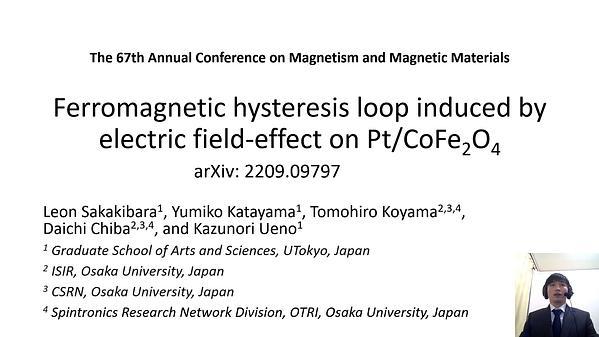Would you like to see your presentation here, made available to a global audience of researchers?
Add your own presentation or have us affordably record your next conference.
Ultrathin ferromagnetic strips, sandwiched between a heavy metal and an oxide, have been suggested as potential platforms for recording devices where the information is coded in perpendicular magnetized domains (up or down) separated domain walls (DWs). Due to the Dzyaloshinskii-Moriya interaction, such DWs depict a homochiral Néel configuration 1,2 and are displaced with high velocity (~500 m/s) by current pulses (J~1 TA/m2) 3. However, the writing mechanism for such DW-based devices, that is, a controlled nucleation of domains and DWs, is still challenging. Nucleation is conventionally performed by injecting an electrical current pulse along an orthogonal conducting wire 1. However, the resulting Oersted field that nucleates a new domain also annihilates an already shifted one unless an intricate device layout is used 4. Although some ideas have been proposed to solve this issue 5,6, a simple nucleation scheme remains elusive.
Here we propose a simple geometrical design where both the nucleation and the shifting can be purely achieved by current pulses (Fig. 1(a)). A DW is initially located in the bottom-left arm of the two symmetrical arms close to its junction with the longitudinal strip (LS), where the bits will be coded and shifted. By applying a proper voltage pulse (V2 in Fig. 1(b)), the DW is pushed towards the LS, and split in two new DWs: one at the top-left arm and other entering in the LS. A second pulse along the same bottom-left arm (V2) will shift the new DW along the LS. If injected along the top-left arm (V1), another DW and domain will be nucleated whereas the former DW will be also driven along the LS. Based on this method, new domains (bits) and DWs can be simultaneously nucleated (written) and driven by alternatively applying voltage pulses between one of the two left arms and the LS of the structure. In the talk, we will show by means of realistic simulations the potential of this idea to perform the writing operation in DW-based recording devices.
References
1 S. Emori et al. Nat. Mater. 12, 611 (2013).
2 K.-S. Ryu et al. Nat. Nanotechnol. 8, 527 (2013).
3 I. M. Miron et al. Nat. Mater. 10, 419 (2011).
4 O. Alejos et al. Scientific Reports, 7, 11909 (2017).
5 Z. Luo et al. Appl. Phys. Lett. 111, 162404 (2017).
6 T. Phuong Dao et al. Nano Lett. 19, 9, 5930 (2019).

